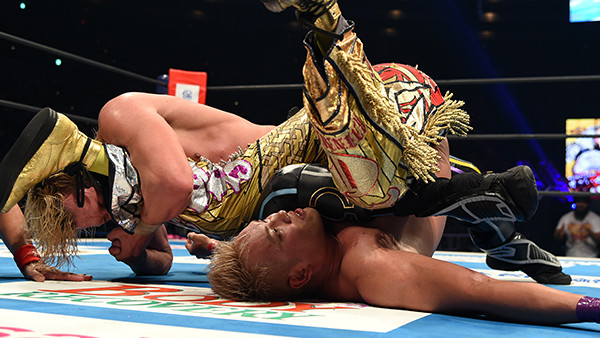Why Kazuchika Okada Vs. Kenny Omega IV Was The GREATEST Wrestling Match EVER

To put over the premise, Omega entered Dominion with a dose of humility. He knew Okada was the superior wrestler - that his only victory was tainted. He instead strove to out-work the IWGP Heavyweight Champion, a motivation that manifested physically as rippled musculature he had never previously boasted. In one of countless moments of storytelling brilliance, Okada, using the sort of strategy that put this over as the perfect fusion of sport and storytelling, sent Omega flying into the guardrail with a dropkick in an attempt to halt Omega’s immediate, electric momentum. This followed a positively awesome spot in which Omega countered Okada’s stupendous over-the-barricade dive with the V-Trigger. He held the answer - but then, Okada, as he has done throughout the last glorious two years, changed the question to an effect that evoked endless empathy.
To put over the crux and importance of the narrative - this, at its core, was an ambitious story of one humble man beating the God-like, fictional ideal of a wrestling champion - every move had to be struck and sold to perfection. This was; Okada crashed into Omega with a thunderous impact. Omega in turn crashed into the metal bone-first with wince-inducing aural horror. Just as Omega competed with Okada, he found himself in internal conflict. His intense stamina preparation compromised, he had to fight wind with will. Omega’s selling was so authentic that he channeled the sympathy of the audience. Even those who admired Okada were locked in battle against him.
This layer of pathos was built on foundational genius - and the Two Out Of Three Falls stipulation was itself layered in its genius.
The modern wrestling match is reliant on content and shortcuts to satisfy a jaded and inattentive audience. This usually renders the first signature move strike almost impotent in its dramatic heft because we know it is not the end. The inherent nature of the match possessed multiple potential endings. Any pinfall attempt in this context would have guaranteed a bite. And still, in its hermetic excellence, Okada in particular sought to extract the maximum drama, literally bending over backwards to take pins, leaving no space from which to escape - to the untrained eye. He kicked out when it was thought physically impossible. By this point, the drama was equally impossible to accept on an emotional level; Omega’s struggle had been escalated so expertly that we needed those two minute rest periods between falls just to catch the breath. The rest periods in themselves, and the boxing/MMA-style confabs between Omega and Kota Ibushi and Okada and Gedo, cast a further cloak of imperceptible illusion. This was presented and thus resonated as a genuine sporting event.
The theme of exhaustion took hold as the match progressed, but not before countless moments of storytelling, character and continuity brilliance were flecked all over Osaka-jo Hall like grains of a sand on a beach. Omega choosing not to chase his table strategy, having learned that to his cost at the Tokyo Dome; Okada, by stumbling at sixteen, extracting hitherto unseen drama from the vastly overused New Japan count-out spot; Okada finding endless, infuriating escapes from the One-Winged Angel, both creating drama and protecting it as pro wrestling’s ultimate weapon; Omega lying prone and pinned following the Rainmaker, with Okada too out of it to register that he needed only a little fingertip to retain the richest prize in the game; Omega using the weapons of his fallen opponents and lovers alike to both echo the brilliance of his arc and put over Okada and his arc as something absolutely unbeatable on his own terms; Omega disrupting Okada’s grand Rainmaker pose with a sick snap dragon suplex, foreshadowing the destruction of the God with this desecration; the subversion of several moves designed to optimise their storyline effectiveness and deliver something new to the audience, like Omega’s sickening V-Trigger to the back of Omega’s head…
CONT'D...